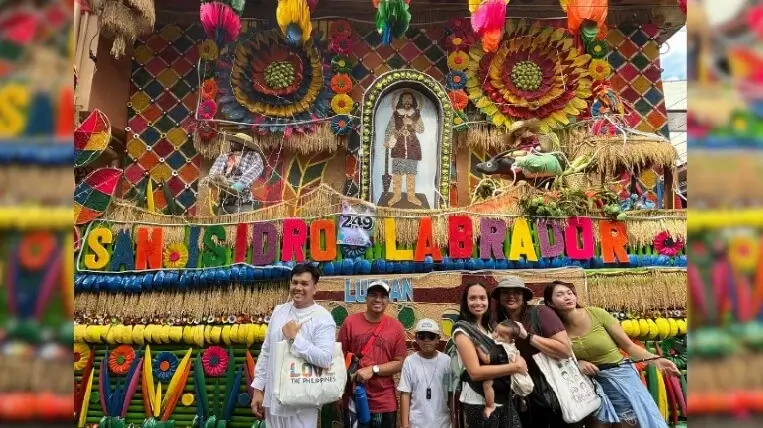
Experiencing the Pahiyas Festival is like stepping into a living canvas—one that celebrates culture, abundance, creativity, and community spirit. This month, I had the privilege of visiting the town of Lucban in Quezon Province, witnessing it transform into a dazzling spectacle of color, all rooted in centuries-old tradition.
Totoo nga, it’s more beautiful in person than what you see on TV or social media. Being in the middle of it all, you feel the warmth of the people, the festive atmosphere, and a kind of vibrant energy that’s hard to put into words.
Imagine: nearly 600 homes decorated with agricultural displays and vibrant kiping, numerous carriages parading through the streets, and several grand arches erected to welcome locals and visitors alike.
And then there’s the aroma—Lucban longganisa sizzling on roadside grills, and the mouthwatering scent of pancit habhab inviting you to dig in with just your hands and a banana leaf.
After taking it all in, here are the things I observed, researched, and gathered through conversations with locals—insights into what makes the Pahiyas Festival such a yanong rikit, baling ganda celebration:
(Yanong rikit, baling ganda are poetic Filipino expressions meaning “natural charm” and “striking beauty.”)
Expression of Gratitude
The Pahiyas Festival is more than just a thanksgiving celebration—it is a cultural bridge that connects Lucbanins to their pre-colonial past. Long before the arrival of Christianity, their ancestors would offer farm produce to native gods as a way of expressing gratitude for a bountiful harvest.
In the 15th century, as the locals embraced Christianity, the tradition evolved and became associated with San Isidro Labrador, the patron saint of farmers, and his wife, Santa María de la Cabeza.
To this day, the people of Lucban continue to celebrate the Pahiyas Festival—a tradition deeply rooted in faith and the spirit of gratitude. It reflects how they artistically combine fruits, vegetables, and other indigenous materials to create vibrant, meaningful decorations that honor both creativity and culture.
I was amazed at how thoughtfully they included images and statues of San Isidro Labrador in their home displays—blending religious devotion with artistic expression in a way that felt both personal and communal.
Cultural Heritage Preservation
The festival was officially organized and evolved into the celebration we know today in 1963, thanks to Fernando Cadeliña Nañawa, then president of the Art Club of Lucban, who helped elevate Pahiyas from a local custom into a widely celebrated cultural event.
Beyond the fruits and vegetables used as decorations, one of the most distinct elements of the Pahiyas Festival is the kiping—a thin, leaf-shaped wafer made from ground glutinous rice, inspired by the kabal tree. These colorful wafers are often arranged into eye-catching aranyas (chandeliers), making them a visual highlight of the celebration.
I had the chance to try grilled kiping—it tasted like a bland ice cream cone, with a brittle texture similar to kropek. Despite its simplicity in flavor, it holds deep cultural meaning. Kiping symbolizes agricultural abundance and stands as a testament to the creative, vibrant spirit of Lucban’s ancestors.
Most families set aside a sack of rice specifically for making kiping, with production starting at least a month before the festival. As long as Pahiyas continues to be celebrated each year, the tradition of crafting colorful kiping and aranyas will live on, preserving this uniquely Lucbanin heritage for generations to come.
Artistic Expressions and Identity
The annual Pahiyas Festival serves as a vibrant avenue for Lucbanins to showcase their artistic expression and celebrate their town’s identity. It’s a time when their maximalist spirit shines in full flamboyance.
Locals proudly display their farm produce and native crafts, transforming their homes and streets into living canvases of creativity. Behind the ornamentation—decorated houses, colorful carriages, and grand arches—lies the soul of Lucban, rooted in the efforts and collaboration of its farmers, artisans, visual artists, and the local government.
They don’t just put their creativity on display—they do it big, making their town the center of celebration alongside neighboring towns that also honor San Isidro Labrador, such as Sariaya, Tayabas, Gumaca, Agdangan, and Tiaong.
As I see it, despite modernization, Lucban continues to honor its past through the Pahiyas Festival by highlighting rural life, farming culture, and enduring Filipino values.
Community Pride and Inclusivity
Many consider Pahiyas the largest and most colorful harvest festival in the country. I can definitely agree. Its inclusive nature is one of the reasons it stands out.
The route of the procession and parade changes every year, and only the homes along the designated streets are encouraged to decorate, based on their harvest and financial capacity, of course.
This approach ensures that everyone has a chance to participate while keeping the celebration sustainable, as not all homes are required to decorate simultaneously. It’s a fair and practical way to keep the tradition alive.
Some residents may join the festivities the following year when their street is included in the parade route. But that doesn’t stop Lucbanins from supporting their neighbors who are participating. The spirit of bayanihan remains strong in Lucban, may I just say, as locals come together to help decorate homes, turning the town into a vibrant, open-air museum.
Tourism and Economic Impact
Festivals boost the economy as they attract both local and international tourists and excursionists, and Lucban’s Pahiyas is no exception.
Fiestas provide livelihood opportunities for farmers, artisans, and small business owners, offering them the perfect time to sell their harvest, handmade goods, food products, and souvenir items.
Beyond the food and crafts industry, the transport sector also benefits, as increased foot traffic means more demand for travel services.
In Lucban’s case, the influx of visitors during the Pahiyas Festival certainly sparked a surge in economic activity. Hotels, restaurants, local markets, and even street vendors experienced a significant increase in income. In fact, we couldn’t book any rooms in the town proper in April, as hotels and Airbnbs had already been fully booked a month before the festival.
As I left Lucban, “Bayan ng mga Superstar,” I brought home more than just snapshots, videos, and pasalubong—I carried with me the stories shared, the genuine warmth of its people, and a deeper appreciation for Filipino culture.
For me, Pahiyas is no longer just a festival—it’s an immersive experience that nourishes the soul and celebrates the richness of Filipino heritage.
You can check the highlights of our Pahiyas Festival 2025 experience here:
You can also check out my travel diaries from Davao City, Davao del Sur, and South Cotabato.
Davao City
24 Hours in Davao City: A Day of Culture, Cuisine, and Scenic Views | Atom Pornel
Davao del Sur
South Cotabato
Cultural Threads: Tracing Traditions from Davao del Sur to South Cotabato | Atom Pornel
Find more Good Travel stories on GoodNewsPilipinas.com and marvel at the beauty of the Philippines!
Join our vibrant Good News Pilipinas community, where we celebrate the achievements of the Philippines and Filipinos worldwide! As the Philippines’ No. 1 Website for Good News and proud winners of the Gold Anvil Award and Lasallian Scholarum Award, we invite you to connect, engage, and share your inspiring stories with us. Together, let’s shine a spotlight on the stories that make every Filipino proud.










